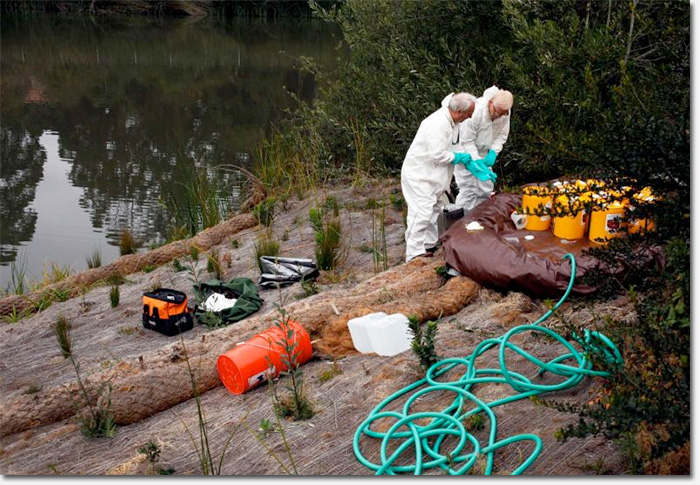
Photo: Pete Kiehart / The Chronicle
As part of an ongoing effort to remediate and restore Mountain Lake to its natural beginnings, the Presidio Trust today took a final step to eradicate the non-native fish population from the lake.
Workers from the Presidio Trust and contractor Fish Control Solutions poured 47 gallons of a poison solution into the 4-acre lake this morning. The solution, which contains 5 percent rotenone, suffocates fish (or anything with gills). The solution is not strong enough to harm other animals like birds that could eat the carcasses or humans that come into contact with the solution.
Workers concluded the four hour poisoning process this morning and by 1pm, estimated that they had recovered 200-300 carp that floated to the surface.
Of the several hundred thousand fish that are in Mountain Lake, planners expect about 20% of the dead fish to float to the surface, and the remaining 80% to sink to the bottom of the lake. Most of the surface fish should be removed today, while a trawler will be employed to remove the fish on the bottom. It’s unclear how long that process will take.
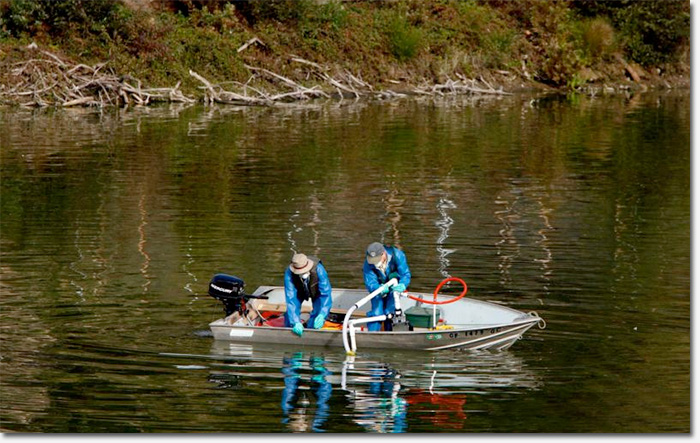
Workers poured the poison solution into the lake from rowboats. Photo: Pete Kiehart / The Chronicle
Most of the fish will be composted in the Presidio, but a “couple of boatfuls” will be given to the Academy of Sciences for research. The Academy will conduct genetic tests to determine where the fish came from.
All traces of the poison solution, which decomposes when exposed to sunlight, are expected to disappear from the water within three days. 6 foot cyclone fences were erected by the lake shore prior to the poisoning per EPA guidelines; they will remain in place for 3 weeks.
This extreme step to eradicate the fish population by poisoning was taken after other measures were employed to remove the array of non-native species that made their home in Mountain Lake, but without complete success. Many of these fish found their way into the lake through dumping from local residents.
Prior to the poisoning, the Trust captured and relocated thousands of fish, turtles and other invasives but found it impossible to capture all the fish. Especially since they were only employing a couple of interns to capture the sometimes monstrous fish.
To prevent residents from dumping their aquatic friends into the lake in the future, the Presidio Trust will have a tank alongside the lake – a kind of safe harbor for relinquished aquatic pets. An education campaign is also planned.
About 100 onlookers, including media, came out to Mountain Lake to watch the poisoning process, which was overseen by Park Police. A “Designated First Amendment Area” was marked with a sign, but no protesters came out.
In about 6 months, conservationists will begin reintroducing native species like three-spined sticklebacks, western pond turtles and chorus frogs.
Thanks to cub reporter David H. for help on this story.
Sarah B.
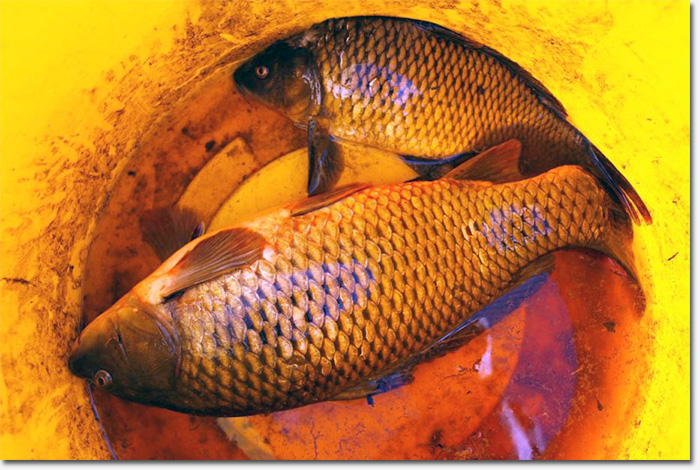
Two poisoned carp that were shown to the media. Photo: Pete Kiehart / The Chronicle

One of the beastly fish that was removed in prior eradication attempts. Photo by Jonathan Young
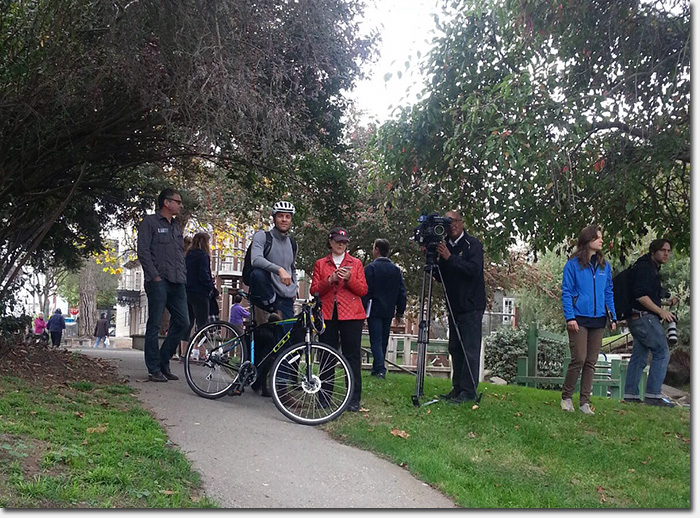
Some onlookers near the playground. Photo by David H.
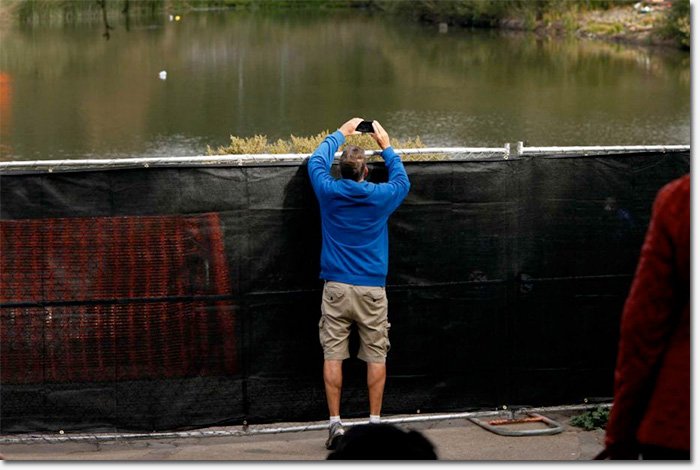
Photo: Pete Kiehart / The Chronicle
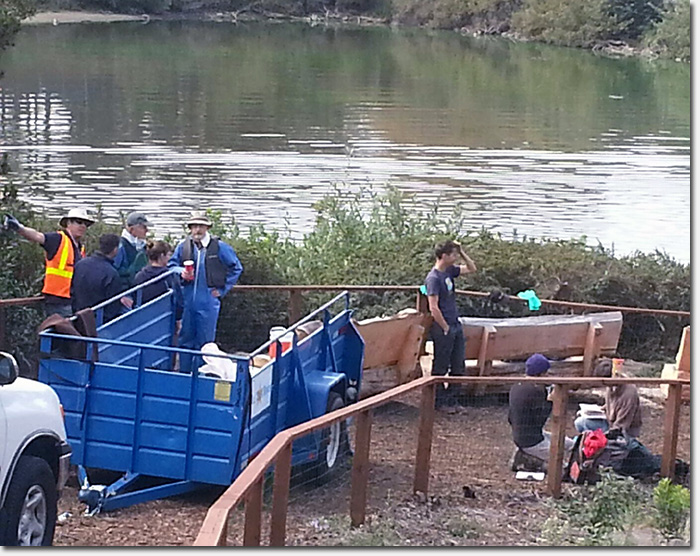
Photo by David H.
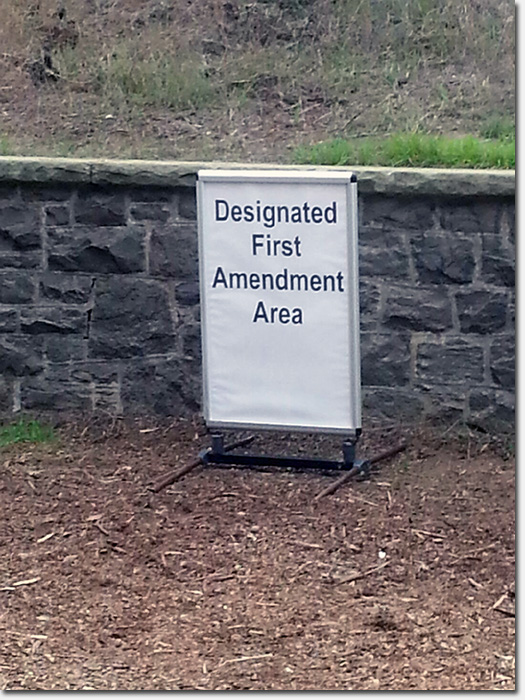
Photo by David H.
I was under the, perhaps mistaken, impression that the whole of the U.S. is a First Amendment area.
That being said, it is nice to see this restoration going forward,
What about the people that like the non native fish do we get a say? If we’re restoring habitat lets turn the whole Presidio into an indian reservation since the native Americans are the only ones truly native to this land. What a flawed way of thinking…
“The First Amendment area” say who!!!!!!!!!!!! People didn’t give limbs and their lives for this country for some brazen S.O.B. to deprive them of their rights. SF= insanity.
This makes me sad. 🙁 With the proper equipment, what’s to say they couldn’t remove the fish earlier?
And people will continue (albeit wrongly) to dump their pets there. So… then what?
From my understanding, they have been hard at work trying for 3 years to remove all of the aggressive fish, in a more natural way. But the carp in there reproduce at such a high rate that those efforts couldn’t keep up. The fish in there were so aggressive, it would have prohibited the native species from surviving in that area.
They released a short documentary that Jonathan Young pointed me out to. The video shows the ideas of the project and what we can expect to see once completed. Some of the species they will be studying seem like a great opportunity to further the study of these species!
https://www.youtube.com/watch?v=xY4yTgCaDuI&list=UUq5MY3g4d000F7RI0kLzwxw
haha the most insulting thing about this is the “designated 1st amendment area”. yeeeesh, how crass.
whatever on the “restoration” plans. the landscape was always manufactured, even before the white folk got here. a well-managed native ecosystem will be much more resilient to potential invaders. let’s try this new thing that the presidio trust wants to do.
What a strange undertaking this is/was. I don’t think a tank for ‘relinquishing aquatic pets’ seems like a good idea. Who will maintain it? Will saltwater/freshwater pets mix and mingle? Will it just become a nasty container of dead and moldy fish/frogs/turtles?
I do love that photo of the guy with the huge fish. Goodness.
This makes me incredibly sad.
….and after this is done the kids will be able to enjoy the poison too
That lake has been a cesspool since I was a child 50 yrs ago, & we never played in it because it was gross. There was a rope tied on a high tree branch behind the lake that all us kids would swing on out over the lake. Pretty dumb considering, but that’s what kids did for fun back then. Someone kept cutting the rope down…those kill joys. Hahaha
Does anyone remember the creepy stories of the lake, like cars disappearing in it?
I totally remember the rope swing at Mountain Lake — one friend fell off into the water and we were afraid to tell her parents what happened.
The creepy story we told and retold was that the entire lake bottom was quicksand! Obviously that is what happened to the disappearing cars 🙂
Oh yeah! I remember it was quicksand in the lake! Hahahha
Quicksand, absolutely!
For those concerned by the “First Amendment Area” I expect this was set up to keep various opiners safe from the chemical in use and work taking place. It is rather rude to interfere with people doing their jobs.
This is not a natural lake – it is a man made, artificial ecosystem. Money and efforts spent on trying to eradicate non-native speciies will ultimately fail, since there is nothing to prevent their re-introduction in the future. This makes as little sense as closing down Sharp Park Golf Course to save endangered species, which reside there only because of the existence of the Golf Course. And the “preservation” plan for Sharp Park included excavating 200+ acres 4 feet deep, and the removal of 13,000 (non-native) trees, both which provide habitat for (non-native) wildlife. A little more common sense (with respect to non-native flora and fauna) would go a long way. Too bad there is so little common sense to go around.
Mountain Lake is not a man-made lake — it is natural.
@Richmondman. It’s a natural lake from a spring. Though the aesthetics of the landscape was designed.
Are there any readers who contributed their, or their children’s, goldfish to the lake?
Been over 15 yrs. since the spotting of the alligator in the lake & non-capture from the gator man, & they have a long lifespan. If he’s still alive, I guess after the chemicals he won’t be.
What bother me about this is all the wasted time and excess cost. The large cost of dredging the lake did not have to happen if they were going to kill all the fish anyway. They could have pumped the lake out, temporarily capped and bypassed by pipe the spring, and done a much better-faster-cheaper job of removing the heavy metals with tractors.
So instead they end up killing everything anyway AND we have the larger cost of dredging as well. In the private sector a manager(s) making such a economically stupid choice would fine themselves on the unemployment line.
I attended the Trust’ meeting about the project. A frank, we’ll thought out project that took many factors into consideration. Open questions from the community including a strong anti-poison use person were calmly discussed. One experienced engineer or professor said something like, “we often have to make a choice between the least harmful poison.”
It’s a cool project, run by caring smart people with complete community involvement. Check it out.
I just want to point out, ROTENONE, the poison used lately to kill everything in Mountain Lake, was employed unsuccessfully in 1954 in the Black Lagoon in an attempt to kill The Creature (it did not work) – http://www.imdb.com/title/tt0046876/faq#.2.1.15
@Dr_Acula: Yes, there are many know instances of incorrect use of Rotenone. Each one added to the learning and skills of the professionals. These issues were discussed at the meeting at well. One notable instance involved the carrier of Rotenone – which did hang around too long and is potentially harmful. The substance itself dissipates rapidly. Surprised a doctor is tossing out old cases as proof.
Moe you kidding right. Creature From The Black Lagoon. IMDB link. Dr Acula. “Dracula”. lolz. Moe what’s your phone number I want to call you and ask for Seymore Butts